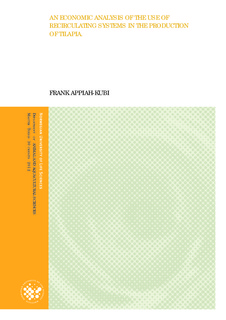| dc.description.abstract | An economic analysis of tilapia production was conducted using a recirculating aquaculture system facility, situated at the Norwegian University of Life Science (UMB). The goals were; (1) to evaluate and estimate the operational cost involved and from this, estimate the breakeven cost, (2) identify and describe the constraints unique to the RAS, (3) to perform financial feasibility of a (hypothetical) scale-up production, and (4) to conduct sensitivity analysis on some variables to highlight their effect on profitability. All assumptions made in this study, production scale and the economic analysis were based on the technology design, and production parameters existing at the UMB facility.
Tilapia (0.36g), were stocked in the tanks; temperature and water quality parameters were carefully managed until the fish reached the harvestable size (700g) after 140days. The survival rate and feed conversion ratio (FCR) were 91% and 0.8 respectively. Economic analyses was conducted on three different production scenarios, (1) ‘actual’ production carried out at the UMB facility, (2) analysis on the same scale of production, with the introduction of some correctional data from commercial productions, and (3) scale-up (hypothetical) production system based on the design criteria of the UMB facility.
The results showed that, the operational cost involving the UMB production was high and economically not viable. A price of NOK 73 is required to be able to breakeven relative to the prevailing market price of NOK 40. The production in this scenario needed to be increased by 54.8%, to be able to breakeven.
The introduction of cost data from commercial productions in the second analysis resulted in a drastic reduction in operational cost. Breakeven price and breakeven yield estimated were NOK 42.7 and 1163kg respectively. However, for the scale-up production, NOK 40.2 was the estimated cost to breakeven. The breakeven yield estimated for the scale-up production was 109663kg of tilapia. Indications thus, were that, prospects for economic success with RAS under Norwegian conditions can be improved by a large scale production. The sensitivity analysis revealed that, reductions in the cost of production variables such as labour, feed, and electricity, have marginal effects on profitability. Increases in sales price and production scale were found to have the highest impacts on profitability and improvements in these variables would yield maximum profit. | no_NO |
